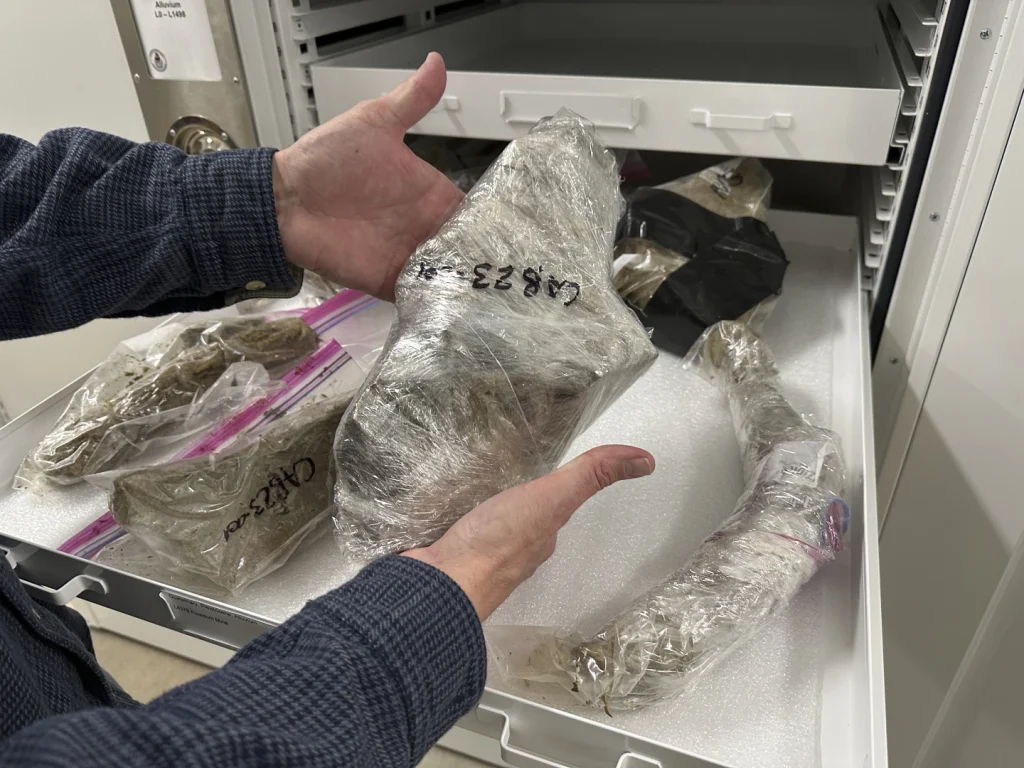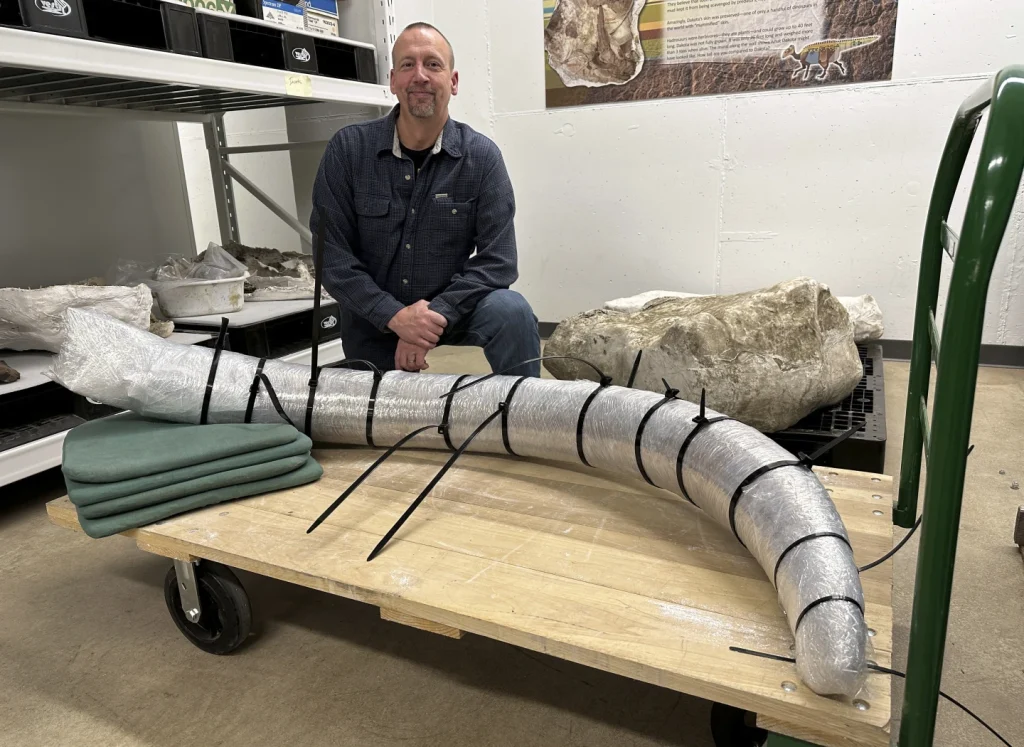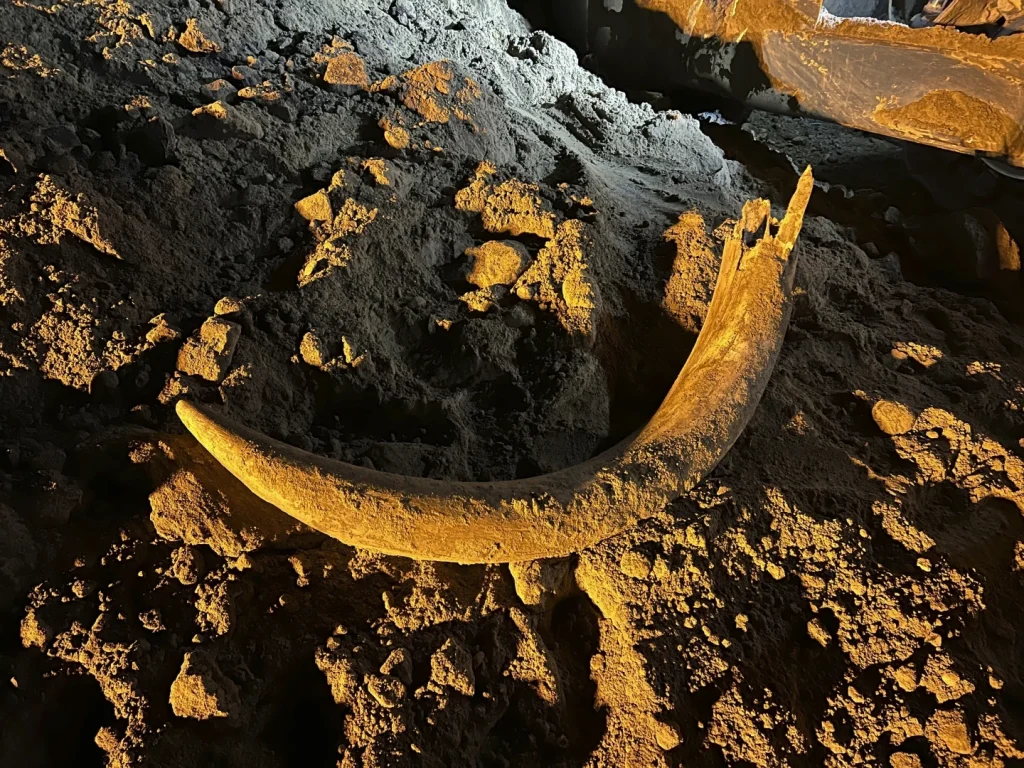The recent discovery of a 7-foot-long mammoth tusk in a North Dakota coal mine has captured the attention of archaeologists and paleontologists around the world.
The unearthing of such a rare and significant artifact has provided valuable insight into the prehistoric era and has sparked a renewed interest in the study of mammoths and other ancient creatures.
The discovery of the mammoth tusk was a serendipitous event, as it was initially spotted by a shovel operator working the overnight shift at the mine.
The glint of white caught his eye as he scooped up a mound of dirt, prompting him to investigate further. This initial observation set off a chain of events that ultimately led to the unearthing of the tusk and the realization of its historical significance.
Following the shovel operator’s discovery, the tusk was further examined by a dozer driver who also noticed the unusual white object amidst the dirt.
It was only then that the miners realized the magnitude of their find and the potential implications it held for the scientific community.
David Straley, an executive of North American Coal, which owns the mine, expressed the company’s astonishment and gratitude at the discovery, stating,
“We were very fortunate, lucky to find what we found.” Indeed, the unearthing of the mammoth tusk has opened up a world of possibilities for researchers and has shed light on the rich history of the region.
The significance of the mammoth tusk cannot be overstated. Mammoths, which roamed the earth during the Pleistocene epoch, are a crucial part of our planet’s history.
Their existence and eventual extinction have long been a subject of fascination and study for scientists and historians alike.
The discovery of a well-preserved tusk provides an invaluable opportunity to learn more about these magnificent creatures and the environment in which they lived.
Furthermore, the location of the discovery adds another layer of intrigue to the find. North Dakota, with its rich geological history, has been the site of numerous fossil discoveries over the years.
The unearthing of the mammoth tusk adds to the state’s reputation as a treasure trove of prehistoric artifacts and reinforces the importance of preserving and studying its natural resources.
In light of this discovery, it is essential that efforts are made to preserve and protect the mammoth tusk and the surrounding area.
The tusk holds immense scientific and historical value and must be handled with care to ensure that it can be studied and appreciated for generations to come.
Additionally, the site of the discovery should be thoroughly examined by experts to determine if there are any additional artifacts or fossils waiting to be unearthed.
The discovery of the mammoth tusk in the North Dakota coal mine serves as a reminder of the importance of continued exploration and preservation of our planet’s history.
It is a testament to the power of curiosity and the potential for unexpected discoveries in the most unlikely of places.

As researchers and scientists delve into the mysteries of the mammoth tusk, we can only anticipate the wealth of knowledge and insight that will be gained from this remarkable find.
The recent discovery of a mammoth tusk and associated bones at the Freedom Mine near Beulah, North Dakota has sparked significant interest and excitement among paleontologists and researchers.
This remarkable find sheds light on the prehistoric landscape of the region and provides valuable insights into the ancient ecosystems that once existed in North America.
The tusk, unearthed from an old streambed approximately 40 feet deep, has been estimated to be between 10,000 and 100,000 years old, making it a truly ancient artifact.
The fact that it remained relatively intact despite the use of heavy mining equipment is nothing short of miraculous, as noted by Jeff Person, a paleontologist with the North Dakota Geologic Survey.
This discovery has opened up a window into the past, offering a glimpse into the life of a mammoth that once roamed the area.
Following the initial discovery of the tusk, further excavation efforts at the site led to the unearthing of more than 20 bones, including a shoulder blade, ribs, a tooth, and parts of hips.
While this collection of bones may not represent a complete skeleton, it is significant in that it provides researchers with a cohesive set of remains from a single animal.
This level of coherence in the findings is rare and offers a unique opportunity to study the mammoth in greater detail.
Paul Ullmann, a vertebrate paleontologist at the University of North Dakota, highlighted the significance of the discovery, emphasizing that while mammoth remains have been found throughout the United States and Canada, the level of completeness and association of the bones found in North Dakota is particularly noteworthy.
This find has the potential to significantly contribute to our understanding of mammoth behavior, ecology, and evolutionary history.
Mammoths, which once roamed various continents including Africa, Asia, Europe, and North America, have long captivated the interest of scientists and the public alike.
Their immense size, distinct appearance, and the mysteries surrounding their extinction have made them a subject of fascination and ongoing research.
The discovery of this mammoth at the Freedom Mine adds another piece to the puzzle of mammoth existence in North America, offering valuable data for researchers to analyze and interpret.
In conclusion, the unearthing of the mammoth tusk and associated bones at the Freedom Mine near Beulah, North Dakota represents a significant milestone in paleontological research.
The findings provide a rare opportunity to study a relatively complete set of mammoth remains, shedding light on the ancient history of the region and contributing to our understanding of these magnificent creatures that once roamed the earth.
This discovery underscores the importance of continued exploration and excavation efforts in uncovering the secrets of our planet’s prehistoric past.
The discovery of mammoth remains in North Dakota has sparked widespread interest and fascination, shedding light on the rich paleontological history of the region.
This rare find has unveiled a window into the prehistoric era, offering a glimpse into the lives of ancient creatures that once roamed the earth.
The significance of this discovery lies not only in its scientific value but also in its potential to captivate and educate future generations.
In this essay, we will delve into the implications of this discovery, the geological context of North Dakota, and the broader significance of paleontological findings in shaping our understanding of the past.
The unearthing of mammoth remains in North Dakota is indeed a rare occurrence, as the region has been subject to the destructive forces of glaciations and ice sheet movements, which have obliterated many remnants of the animals that inhabited the area during the last Ice Age.
Dr. Ullmann’s assertion underscores the exceptional nature of this discovery, highlighting the challenges posed by the geological history of the region.
Comparisons with other areas, such as Texas, South Dakota, Canada, and Siberia, where mammoth remains have been more abundant, serve to emphasize the unique nature of the North Dakota find.
The extinction of mammoths approximately 10,000 years ago in what is now North Dakota holds profound significance in understanding the dynamics of ancient ecosystems.
These colossal creatures, larger than today’s elephants and adorned with thick wool, have left an indelible mark on the landscape and human history.
Cave paintings dating back 13,000 years depicting mammoths provide a testament to the enduring fascination with these majestic beasts.
Dr. Ullmann’s comparison of mammoths to “media superstars almost as much as dinosaurs,” drawing a parallel with the popular “Ice Age” film franchise, underscores the enduring allure of these ancient giants.
The delicate nature of the mammoth ivory tusk, weighing over 50 pounds, necessitates meticulous preservation measures to prevent its deterioration.
The careful wrapping in plastic and controlled dehydration efforts underscore the dedication of paleontologists to safeguard and study these invaluable relics.
The planned donation of the bones to the state for educational purposes reflects a laudable commitment to sharing this discovery with future generations.
The aspiration to provide children with the opportunity to engage with these relics speaks to the potential of paleontological findings to inspire and educate young minds.
North Dakota’s paleontological landscape, replete with bones, fossils, and the remnants of ancient life, presents a tapestry of geological and ecological richness.
From the mummified duckbilled dinosaur, Dakota, with fossilized skin, to the diverse array of fossils, the state’s fossil record attests to the abundance of prehistoric life that once thrived in its low-elevation, ecologically productive environments.

Dr. Ullmann’s elucidation of the geological factors that have contributed to the preservation of animal remains for millions of years underscores the fortuitous convergence of environmental and geological conditions that have endowed North Dakota with its rich paleontological heritage
The discovery of mammoth remains in North Dakota serves as a poignant reminder of the enduring allure of paleontological finds and their capacity to illuminate the mysteries of the past.
As we contemplate the implications of this discovery, we are reminded of the importance of preserving and sharing these treasures with future generations.
North Dakota’s paleontological landscape stands as a testament to the intricate interplay of geological forces and ecological abundance that have preserved the relics of ancient life for millennia.
As we continue to unravel the secrets of the prehistoric past, these discoveries serve as beacons of wonder and knowledge, inviting us to contemplate the vast tapestry of life that has unfolded over millions of years.
